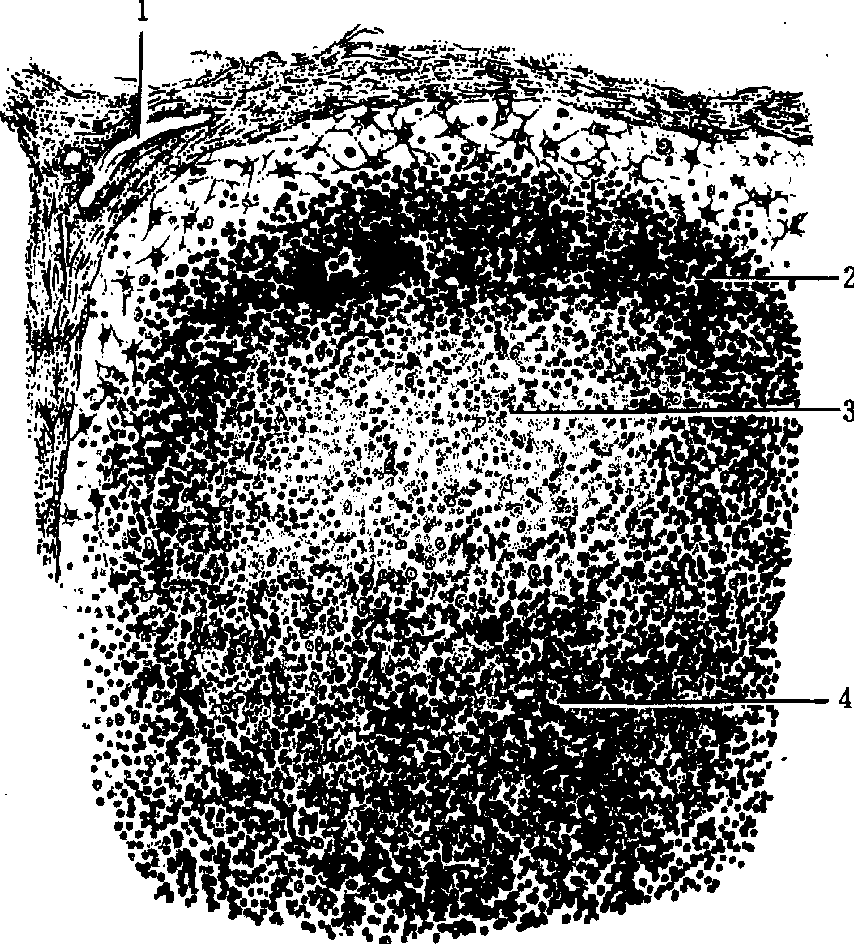淋巴器官lymphatic organs
以淋巴组织为主形成的实质器官。可分为初级和次级淋巴器官。初级淋巴器官亦称中枢淋巴器官,是培育具免疫活性淋巴细胞的场所,胸腺和腔上囊属之。哺乳动物缺乏腔上囊,一般认为骨髓是其类同器官。这类淋巴器官发生较早,动物出生时已基本发育完善,但退化也较早。其网状细胞来源于内胚层上皮,称上皮性网状细胞,不能产生网状纤维,但能分泌激素;在其诱导下,从骨髓迁移来的干细胞分裂分化形成具有识别特异性抗原能力的淋巴细胞。次级淋巴器官亦称周围淋巴器官,是产生免疫应答的场所,淋巴结、脾、血结和血淋巴结属之。扁桃体虽被列入此类,但其网状细胞来源于内胚层上皮。这类淋巴器官在胚胎发育过程中出现较晚,退化也较迟。其网状细胞来源于间充质,不能分泌激素,但能形成网状纤维;从胸腺、腔上囊或骨髓迁移来的淋巴细胞分别居留于其一定区域,在抗原的刺激下,这些淋巴细胞可进一步分裂分化,形成具有相同特异性的淋巴细胞或浆细胞。
淋巴组织由富含淋巴细胞的网状组织组成,即网状细胞间的网眼中充满淋巴细胞,其中常伴有巨噬细胞和浆细胞等。淋巴组织通常形成弥散性淋巴组织与淋巴小结。在哺乳动物,它们除在淋巴回流和血液循环的通路上构成淋巴器官外,还广泛分布于消化道、呼吸道和泌尿生殖道的粘膜固有层和粘膜下层,可滤过组织液,增强局部组织的抵抗力,在病菌尚未引起全身性反应之前将其就地消灭。弥散性淋巴组织形态结构不定,大小不一,与周围结缔组织无明显界限,淋巴细胞密集而均匀,其中T细胞常多于B细胞,还存在若干巨噬细胞、数量变化不定的浆细胞,以及毛细血管后微静脉。
淋巴小结亦称淋巴滤泡,呈球形、卵圆形或锥形,中央为由明区和暗区组成的生发中心,明区上方覆盖有密集的小淋巴细胞组成的帽(见图)。生发中心与周围弥散性淋巴组织之间有若干层呈同心圆排列的网状细胞。淋巴小结的淋巴细胞主要为B细胞,也有少量T细胞、树突细胞和巨噬细胞等。淋巴小结的分布方位常有一定,例如,其明区与帽在消化道与呼吸道常朝向粘膜表面; 在淋巴结朝向淋巴窦,在脾朝向红髓。淋巴小结是一种多变的结构,在抗原的刺激下形成与增生,抗原被清除后又逐渐消失。粘膜内单独存在的淋巴小结称淋巴孤结,聚集成群时称淋巴集结。

淋巴小结典型结构
1. 输入淋巴管; 2. 被膜; 3. 被膜下淋巴窦; 4. 帽
淋巴器官
免疫系统中培育各种淋巴细胞和引起免疫反应的重要结构,主要由淋巴组织构成。淋巴组织有两种,一种为弥散的淋巴组织,密集而无明显境界;另一种为淋巴小结,圆形或椭圆形,位于弥散淋巴组织之中。淋巴器官包括胸腺、淋巴结、脾、扁桃体等。
淋巴器官lymphatic organ
主要由淋巴组织构成的器官。包括中枢淋巴器官,即胸腺和鸟类腔上囊,和周围淋巴器官,即淋巴结、脾脏、扁桃体、血结和血淋巴结等。中枢淋巴器官是将干细胞培育为成熟淋巴细胞的场所,其中胸腺培育T淋巴细胞成熟,腔上囊培育B淋巴细胞成熟。周围淋巴器官是进行免疫应答的场所。